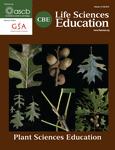Plant Behavior
Plants are a huge and diverse group of organisms (Figure 1), ranging from microscopic marine phytoplankton (see http://oceandatacenter.ucsc.edu/PhytoGallery/phytolist.html for beautiful images of many species) to enormous terrestrial trees epitomized by the giant sequoia: 300 feet tall, living 3000 years, and weighing as much as 3000 tons (visit the Arkive website, www.arkive.org/giant-sequoia/sequoiadendron-giganteum, for photos and basic information). Stunning, and yet some of us take plants for granted, like a side salad. We may see plants as a focal point during the blooming season or as a nice backdrop for all the interesting things animals do. For this plant issue of CBE—Life Sciences Education, I am going to focus on a botanical topic that most people, even biologists, do not think about—plant behavior.
Before digging into plant behavior, let us define what a plant is. All plants evolved from the eukaryotic cell that acquired a photosynthetic cyanobacterium as an endosymbiont ∼1.6 billion years ago. This event gave the lineage its defining trait of being a eukaryote that can directly harvest sunlight for energy. The cyanobacteria had been photosynthesizing on their own for a long time already, but this new “plant cell” gave rise to a huge and diverse line of unicellular and multicellular species. Genome sequences have shed light on the birth and evolution of plants, and John Bowman and colleagues published an excellent review titled “Green Genes” several years ago in Cell (www.sciencedirect.com/science/article/pii/S0092867407004618#;Bowman et al., 2007). The article has concise information on the origin and evolution of plant groups, including helpful graphics (Figure 2). Of course, plants were classified and subdivided long before DNA analysis was possible. The Encyclopedia of Earth (EOE) is a good website for exploring biological diversity and has an article on plants (www.eoearth.org/view/article/155261) that lays out the major plant groups and their characteristics. It states that there are more than 400,000 described species, a fraction of the estimated total number.
The venerable Kew Gardens has an excellent website (Figure 3) that includes extensive pages under the tab Science and Conservation (www.kew.org/science-conservation). It is a beautifully organized website for exploring plant diversity and burrowing into the science of plants, and includes an excellent blog. Ever wonder how many different kinds of flowers there are? You can find out by visiting their feature titled, “How Many Flowering Plants Are There in the World?” There is an interesting video feature on coffee, which describes how only two species out of more than a hundred have come to dominate coffee production for drinking. As the monoculture in Ireland led to the potato blight, a lack of genetic diversity in today's coffee plants is threatening the world's coffee supply with the onset of climate change. The possibility of life without coffee is a call to action if ever I have heard one.
Figure 1. Plants are very diverse, ranging in size from microscopic plankton (left, courtesy of University of California–Santa Cruz Ocean Data Center) to the biggest organisms on our planet (right, courtesy Arkive.org).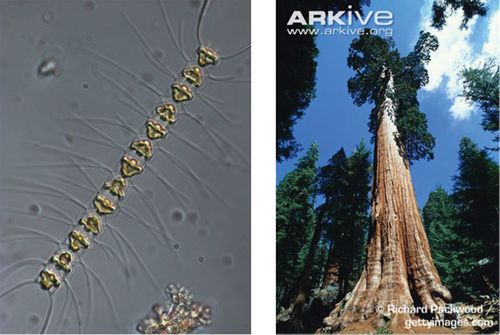
Figure 2. Genomic analysis has illuminated the relationship among the many species of plants, as illustrated in this phylogeny of three major plant groups from Bowman et al. (2007, p. 129).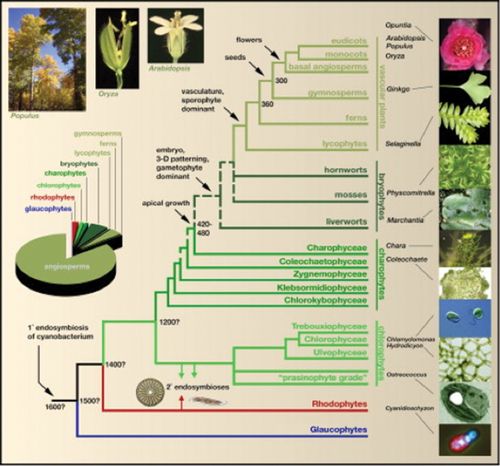
Figure 3. Kew Gardens has a large and informative website that should appeal to gardeners and flower lovers, as well as more serious botanists and ecologists.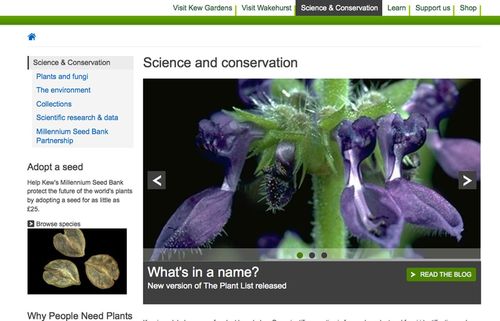
Classification of plants is challenging for students and teachers alike. Perhaps understandable, given that plants constitute an entire kingdom of life. For an overview, have students read the EOE article as well as the Bowman Cell article to appreciate the enormity and diversity of the organisms we call plants. The EOE article is reproduced on the Encyclopedia of Life website (http://eol.org/info/449), an excellent context for further exploration of diverse plant species. As we probe the topic of plant behavior, the examples will be drawn from the vascular plants that include the many familiar plants commonly called trees, shrubs, flowers, vegetables, and weeds.
Plants do respond to changes in their environment, but is it fruitful or scientifically valid to say that they have behavior? They lack muscles and nerves, do not have mouths or digestive systems, and are often literally rooted in place. A growing number of plant biologists have embraced the term behavior, as demonstrated by the journal devoted to the subject, Plant Behavior. Their resources page (www.plantbehavior.org/resources.html) is a good place to get oriented to the field.
As in so many things, Darwin anticipated important questions concerning the movement of plants, despite the difficulties in observing plant behavior, and in 1880 he published The Power of Movement in Plants. The Darwin Correspondence Project website has a good treatment of Darwin's work on plants, with interesting anecdotes relating to how he collaborated with his son Francis on this work late in his career (www.darwinproject.ac.uk/power-of-movement-in-plants). You can download Chapter 9 of the book and some of the correspondence between Darwin and his son. The entire book is available at http://darwin-online.org.uk/content/frameset?itemID=F1325&viewtype=text&pageseq=1, or in various e-reader formats at the Project Gutenberg website (http://www.gutenberg.org/ebooks/5605). The PBS NOVA website, has a feature covering several of Darwin's “predictions,” including one in which he noted the importance of plant and animal interactions. He famously predicted that a Madagascar orchid (Angraecum sesquipedale), which has a long narrow passage to its nectar stash, must have a long-tongued pollinator. In 1903, biologists identified the giant hawkmoth, with a 12-inch-long proboscis, as the pollinator predicted by Darwin (www.pbs.org/wgbh/nova/id/pred-nf.html).
Darwin recognized that plants mostly do things on a timescale that is hard for us to observe, so he devised clever ways to record their movements. Placing a plant behind a pane of glass, he marked the plant's position on the glass over time using a stationary reference grid placed behind the plant. Darwin transferred the drawing to a sheet of paper before cleaning the glass for the next experiment (Figure 4). By varying the distance between the plant, the reference points, and the glass, he magnified apparent distances to detect even small plant movements over periods as short as minutes. High-definition time-lapse photography and other modern techniques have extended Darwin's observations in some compelling directions.
Figure 4. One of Darwin's drawings that can be found on the Darwin Correspondence Project Web pages devoted to his book The Power of Movement in Plants. For this figure, the position of the cotyledons of a Brassica was marked on a glass plate about every 30 min over a period of more than 10 h.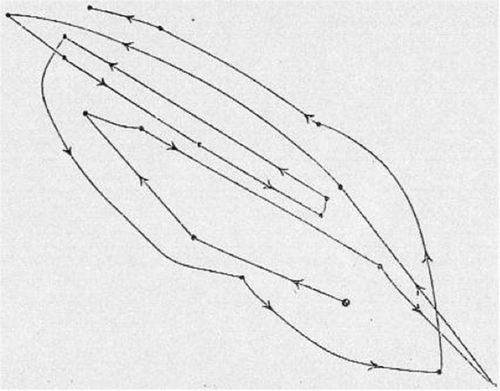
A recent episode of the PBS Nature series, “What Plants Talk About,” epitomizes the increased interest in plant behavior and, unfortunately, some of the hyperbole associated with the field. The time-lapse video sequences and associated science are fascinating, and the entire program can be viewed on the PBS website at http://video.pbs.org/video/2338524490. The home page for the program (Figure 5; www.pbs.org/wnet/nature/episodes/what-plants-talk-about/introduction/8228) has two short video clips that are interesting. The video titled “Dodder Vine Sniffs Out Its Prey” is nicely filmed and features some interesting experiments involving plant signaling. It might be instructive to ask students to respond to the vocabulary used in the narration, which unfortunately tries to impart intent and mindfulness to the plant's activities, and to make sensible experimental results somehow seem shocking. The “Plant Self-Defense” video is a compelling “poison pill” story that needs no narrative embellishment. A plant responds to caterpillars feeding on it by producing a substance that tags them for increased attention from predators. Increased predation reduces the number of caterpillars feeding on the plants. The story offers a remarkable series of complex interactions and evolutionary adaptations. Another documentary, In the Mind of Plants (www.youtube.com/watch?v=HU859ziUoPc), was originally produced in French. Perhaps some experimental interpretations were mangled in translation, but the camera work is consistently excellent.
Figure 5. The Nature pages of the PBS website have video clips and a short article, as well as the entire hour-long program “What Plants Talk About.” The program features fantastic camera work and solid science, but some questionable narration.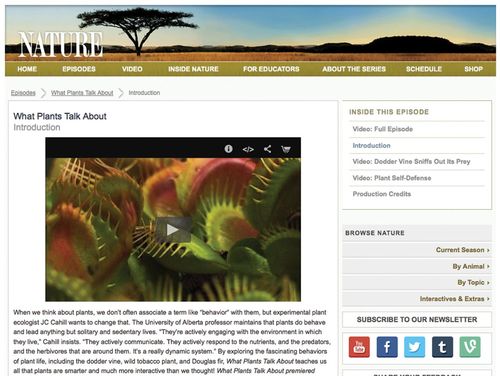
Skepticism is part and parcel of scientific thinking, but particular caution may be warranted in the field of plant behavior because of the 1970s book and documentary called The Secret Life of Plants (www.youtube.com/watch?v=sGl4btrsiHk). The Secret Life of Plants was a sensation at the time and was largely responsible for the persistent myths that talking to your plants makes them healthier, that plants have auras, and that plants grow better when played classical music rather than rock. While the program woke people up to the notion that plants indeed do fascinating things, the conclusions based on bad science or no science at all were in the end more destructive than helpful to this aspect of plant science. Michael Pollan, author of The Botany of Desire and other excellent plant books, addresses some of the controversy that dogs the field of plant behavior in an interview on the public radio program Science Friday (http://sciencefriday.com/segment/01/03/2014/can-plants-think.html). His article “The Intelligent Plant” in the New Yorker (www.newyorker.com/reporting/2013/12/23/131223fa_fact_pollan?currentPage=all), covers similar ground.
The excellently understated Plants in Motion website (http://plantsinmotion.bio.indiana.edu/plantmotion) is a welcome antidote to some of the filmic excesses. The site features dozens of low-definition, time-lapse videos of plants moving, accompanied by straightforward explanations of the experimental conditions and some background on the plants. The lack of narration conveys a refreshing cinema verité quality, and you can choose your own music to play while you watch. Highlights include corn shoots growing toward a light bulb, the rapid response of a mimosa plant to a flame, vines twining, and pumpkins plumping at night. You may have driven past a field of sunflowers and heard the remark that the heads follow the sun, but that is a partial truth. The young buds of the early plants do track the sun, but once they bloom, the tall plants stiffen and every head in the field permanently faces … east! The creators of Plants in Motion curated an exhibit at the Chicago Botanic Gardens called sLowlife (Figure 6). The accompanying video and “essay” (http://plantsinmotion.bio.indiana.edu/usbg/toc.htm) are excellent, featuring many interesting aspects of plant biology.
Figure 6. sLowlife is an evocative multimedia essay designed to accompany an exhibit installed at the Chicago Botanic Gardens. It features text and video that reveal interesting aspects of plant biology.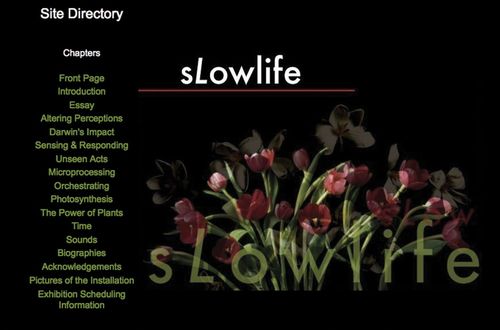
Figure 7. The Carnegie Airborne Observatory is a flying lab that can collect real-time aerial data on forests at resolutions smaller than a single leaf on a tree.
High-definition time-lapse photography is far from the only tool available to reveal hard-to-observe activities of plants. Greg Asner and colleagues at the Carnegie Airborne Observatory are using informatics to study the dynamic lives of plants at the community ecology level. The Airborne Observatory uses several impressive computer- and laser-enabled techniques (http://cao.stanford.edu/?page=cao_systems) to scan the landscape at the resolution of single leaves on trees and in modalities that can yield information at the molecular level. These techniques can yield insights into how forests respond to heat or water stress or the introduction of a new species. The site has a gallery of projects that are best started at this page: http://cao.stanford.edu/?page=research&pag=5. Here, they are documenting the effect of the Amazon megadrought on the rain forest. The very simple navigation at the top right consists of 15 numbered squares for the different projects. Each project is worth paging through to understand how versatile these aerial-mapping techniques are. They also have six buttons of video pages (http://cao.stanford.edu/?page=videos) that give you a feel for what it might be like to be in the air while collecting the data (Figure 7).
If this Feature seems to have been too conservative about whether plants have behavior, visit the LINV blog (www.linv.org/blog/category/plant-behavior) of the International Laboratory for Plant Neurobiology. The term “plant neurobiology” may be going too far, but the website presents some interesting science. Another fascinating dimension of plant “behavior” is seed dispersal, from seeds that can burrow, to seeds that “fly,” to seeds that are shot like bullets. A couple of websites have some good information and photos of the myriad designs that have evolved to take advantage of air currents for seed dispersal; see http://waynesword.palomar.edu/plfeb99.htm and http://theseedsite.co.uk/sdwind.html. The previously mentioned PBS Nature series also produced a program on seeds, “The Seedy Side of Plants,” which you can view at www.pbs.org/wnet/nature/episodes/the-seedy-side-of-plants/introduction/1268. ChloroFilms, a worldwide competition for plant videos, is now in its fourth season, with some really good videos (www.chlorofilms.org). If you love plants, work with plants, or have insights into plant biology, you should consider submitting a video!
ACKNOWLEDGMENTS
The author thanks Malcolm Campbell for helpful editorial suggestions.


